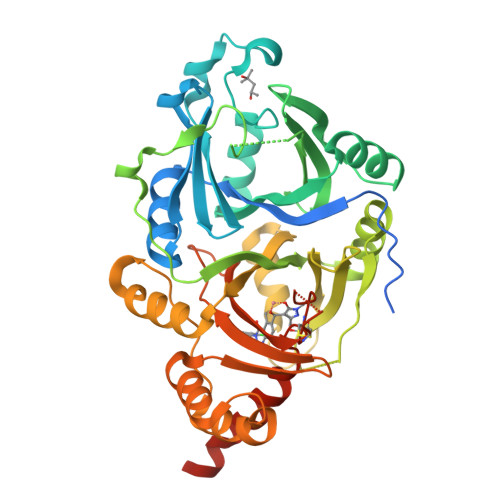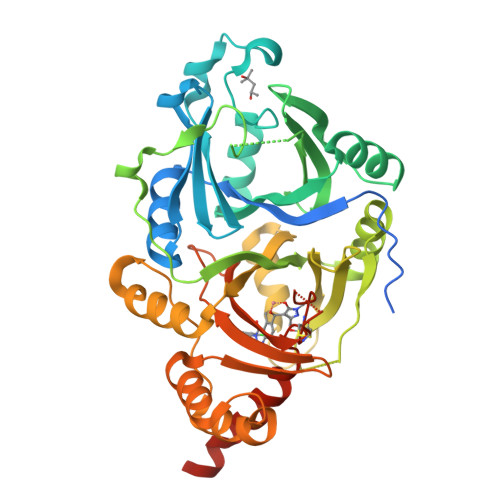Discovery of Novel Pyrazole-Quinazoline-2,4-dione Hybrids as 4-Hydroxyphenylpyruvate Dioxygenase Inhibitors.
He, B., Wu, F.X., Yu, L.K., Wu, L., Chen, Q., Hao, G.F., Yang, W.C., Lin, H.Y., Yang, G.F.(2020) J Agric Food Chem 68: 5059-5067
- PubMed: 32286826
- DOI: https://doi.org/10.1021/acs.jafc.0c00051
- Primary Citation of Related Structures:
6LGT - PubMed Abstract:
4-Hydroxyphenylpyruvate dioxygenase (HPPD, EC 1.13.11.27) has been identified as one of the most significant targets in herbicide discovery for resistant weed control. In a continuing effort to discover potent novel HPPD inhibitors, we adopted a ring-expansion strategy to design a series of novel pyrazole-quinazoline-2,4-dione hybrids based on the previously discovered pyrazole-isoindoline-1,3-dione scaffold. One compound, 3-(2-chlorophenyl)-6-(5-hydroxy-1,3-dimethyl-1 H -pyrazole-4-carbonyl)-1,5-dimethylquinazoline-2,4(1 H ,3 H )-dione ( 9bj ), displayed excellent potency against At HPPD, with an IC 50 value of 84 nM, which is approximately 16-fold more potent than pyrasulfotole (IC 50 = 1359 nM) and 2.7-fold more potent than mesotrione (IC 50 = 226 nM). Furthermore, the co-crystal structure of the At HPPD- 9bj complex (PDB ID 6LGT) was determined at a resolution of 1.75 Å. Similar to the existing HPPD inhibitors, compound 9bj formed a bidentate chelating interaction with the metal ion and a π-π stacking interaction with Phe381 and Phe424. In contrast, o -chlorophenyl at the N3 position of quinazoline-2,4-dione with a double conformation was surrounded by hydrophobic residues (Met335, Leu368, Leu427, Phe424, Phe392, and Phe381). Remarkably, the greenhouse assay indicated that most compounds displayed excellent herbicidal activity (complete inhibition) against at least one of the tested weeds at the application rate of 150 g of active ingredient (ai)/ha. Most promisingly, compounds 9aj and 9bi not only exhibited prominent weed control effects with a broad spectrum but also showed very good crop safety to cotton, peanuts, and corn at the dose of 150 g of ai/ha.
Organizational Affiliation:
Key Laboratory of Pesticide & Chemical Biology of Ministry of Education, International Joint Research Center for Intelligent Biosensor Technology and Health, College of Chemistry, Central China Normal University, Wuhan, Hubei 430079, People's Republic of China.





















